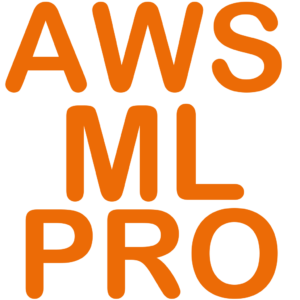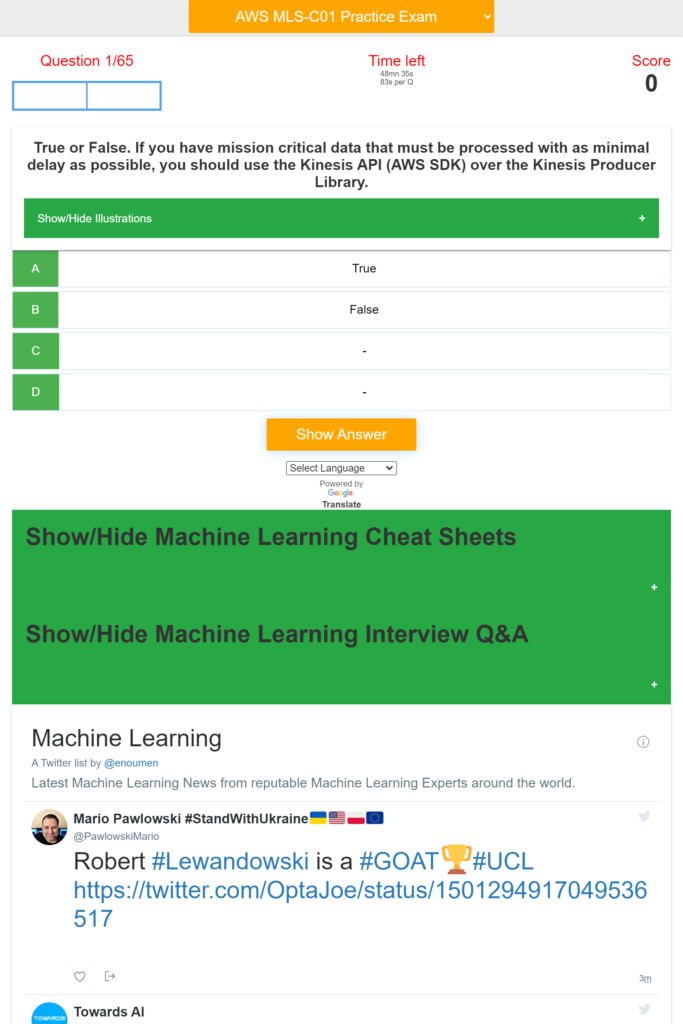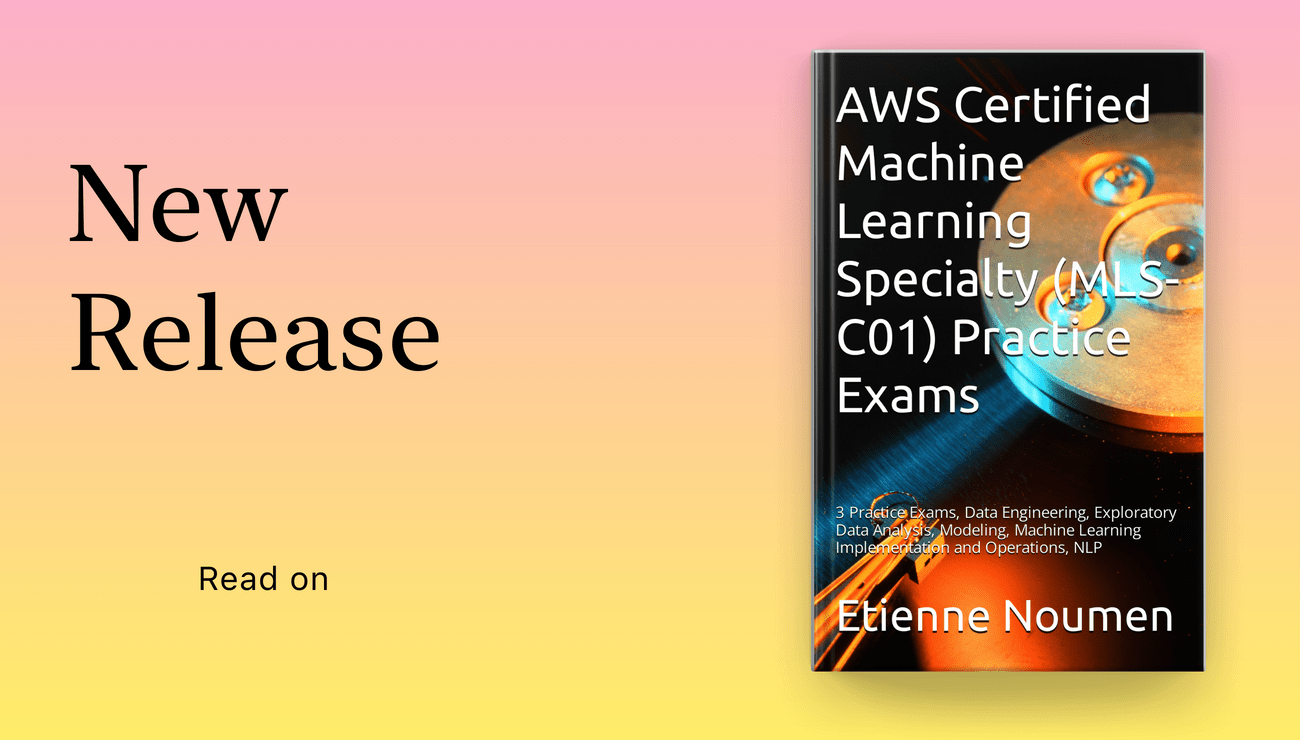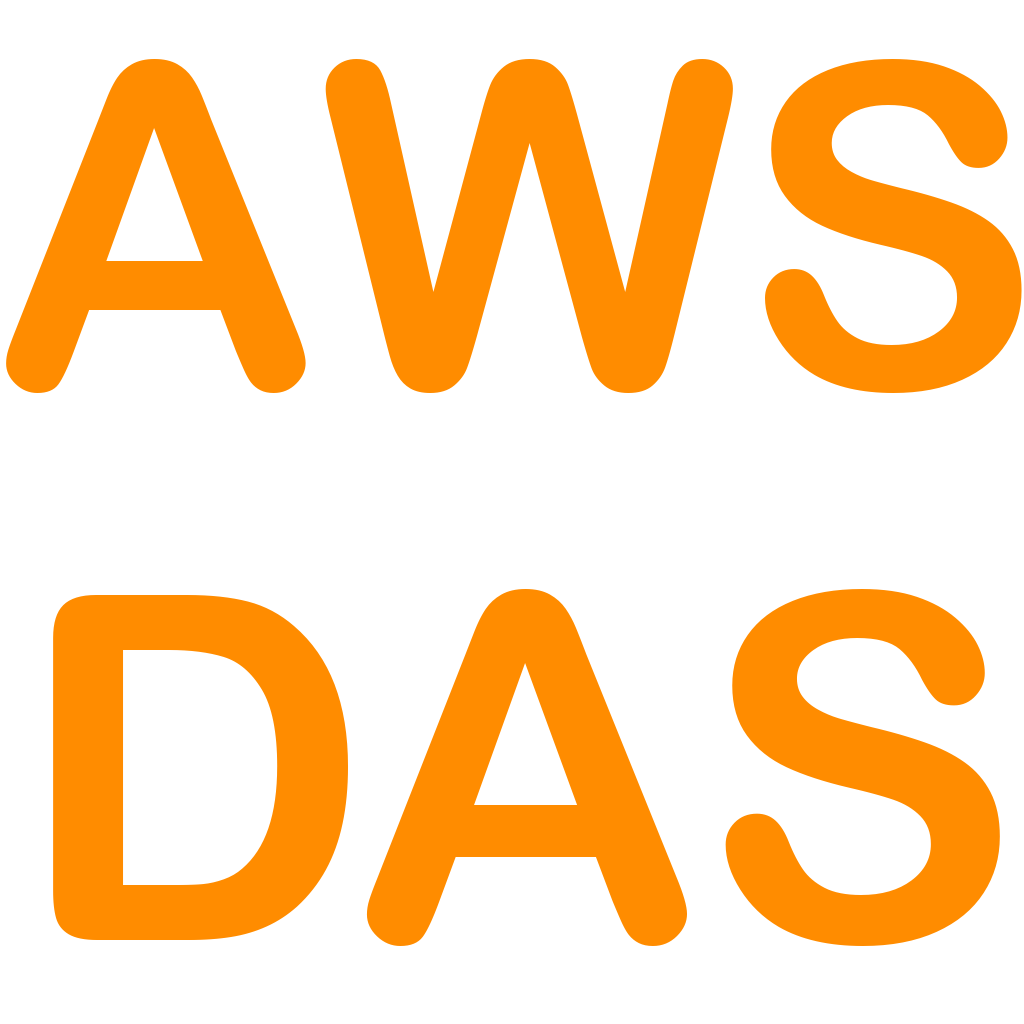You can translate the content of this page by selecting a language in the select box.
The AWS Certified Machine Learning Specialty validates expertise in building, training, tuning, and deploying machine learning (ML) models on AWS.
Use this App to learn about Machine Learning on AWS and prepare for the AWS Machine Learning Specialty Certification MLS-C01.
Download AWS machine Learning Specialty Exam Prep App on iOs
Download AWS Machine Learning Specialty Exam Prep App on Android/Web/Amazon
[appbox appstore 1611045854-iphone screenshots]
[appbox microsoftstore 9n8rl80hvm4t-mobile screenshots]

Download AWS machine Learning Specialty Exam Prep App on iOs
Download AWS Machine Learning Specialty Exam Prep App on Android/Web/Amazon
The App provides hundreds of quizzes and practice exam about:
– Machine Learning Operation on AWS
– Modelling
– Data Engineering
– Computer Vision,
– Exploratory Data Analysis,
– ML implementation & Operations
– Machine Learning Basics Questions and Answers
– Machine Learning Advanced Questions and Answers
– Scorecard
– Countdown timer
– Machine Learning Cheat Sheets
– Machine Learning Interview Questions and Answers
– Machine Learning Latest News
The App covers Machine Learning Basics and Advanced topics including: NLP, Computer Vision, Python, linear regression, logistic regression, Sampling, dataset, statistical interaction, selection bias, non-Gaussian distribution, bias-variance trade-off, Normal Distribution, correlation and covariance, Point Estimates and Confidence Interval, A/B Testing, p-value, statistical power of sensitivity, over-fitting and under-fitting, regularization, Law of Large Numbers, Confounding Variables, Survivorship Bias, univariate, bivariate and multivariate, Resampling, ROC curve, TF/IDF vectorization, Cluster Sampling, etc.
Domain 1: Data Engineering
Create data repositories for machine learning.
Identify data sources (e.g., content and location, primary sources such as user data)
Determine storage mediums (e.g., DB, Data Lake, S3, EFS, EBS)
Identify and implement a data ingestion solution.
Data job styles/types (batch load, streaming)
Data ingestion pipelines (Batch-based ML workloads and streaming-based ML workloads), etc.
Domain 2: Exploratory Data Analysis
Sanitize and prepare data for modeling.
Perform feature engineering.
Analyze and visualize data for machine learning.
Domain 3: Modeling
Frame business problems as machine learning problems.
Select the appropriate model(s) for a given machine learning problem.
Train machine learning models.
Perform hyperparameter optimization.
Evaluate machine learning models.
Domain 4: Machine Learning Implementation and Operations
Build machine learning solutions for performance, availability, scalability, resiliency, and fault
tolerance.
Recommend and implement the appropriate machine learning services and features for a given
problem.
Apply basic AWS security practices to machine learning solutions.
Deploy and operationalize machine learning solutions.
Machine Learning Services covered:
Amazon Comprehend
AWS Deep Learning AMIs (DLAMI)
AWS DeepLens
Amazon Forecast
Amazon Fraud Detector
Amazon Lex
Amazon Polly
Amazon Rekognition
Amazon SageMaker
Amazon Textract
Amazon Transcribe
Amazon Translate
Other Services and topics covered are:
Ingestion/Collection
Processing/ETL
Data analysis/visualization
Model training
Model deployment/inference
Operational
AWS ML application services
Language relevant to ML (for example, Python, Java, Scala, R, SQL)
Notebooks and integrated development environments (IDEs),
S3, SageMaker, Kinesis, Lake Formation, Athena, Kibana, Redshift, Textract, EMR, Glue, SageMaker, CSV, JSON, IMG, parquet or databases, Amazon Athena
Amazon EC2, Amazon Elastic Container Registry (Amazon ECR), Amazon Elastic Container Service, Amazon Elastic Kubernetes Service , Amazon Redshift
Important: To succeed with the real exam, do not memorize the answers in this app. It is very important that you understand why a question is right or wrong and the concepts behind it by carefully reading the reference documents in the answers.
Note and disclaimer: We are not affiliated with Microsoft or Azure or Google or Amazon. The questions are put together based on the certification study guide and materials available online. The questions in this app should help you pass the exam but it is not guaranteed. We are not responsible for any exam you did not pass.

Download AWS machine Learning Specialty Exam Prep App on iOs
Download AWS Machine Learning Specialty Exam Prep App on Android/Web/Amazon
- [D] Looking for a recent study/paper/article that showed that an alternate model with a similar number of parameters to a ViT performed just as well showning that there's nothing special about particular models.by /u/SunraysInTheStorm (Machine Learning) on May 1, 2024 at 5:00 pm
Title basically, this was a conversation I read just recently and am now looking for the source. A specific paper was mentioned in there as well. The conclusion drawn was that we might be at the limit of what we can do with statistical models and that there's nothing special about the models themselves - only the data that's fed matters. Any pointers would be appreciated, thanks! submitted by /u/SunraysInTheStorm [link] [comments]
- [p] AI powered SIEM/NIDSby /u/OpeningDirector1688 (Machine Learning) on May 1, 2024 at 4:50 pm
I know this might be a bit neiche for a subreddit like this but I’m just trying to get as much feedback as possible. I’m making a project. It was originally going to be a a type of AI powered SIEM. It would take in information from multiple network intrusion detection systems and detect patterns. E.g Suricata might flag a low level alert as well as SNORT and other simillar systems the same. Previously these alerts might have been disregarded but an AI powered SIEM could detect a pattern in each of these alerts, decide weather it’s an attack or just a false positive, and then decide what type of attack it is. Upon researching further into this project I have created an AI that can perform this task just from basic Netflow info. I’m aware this is a very broad question to ask but I was just wondering if anyone had any ideas for as the next step in this project. Maybe even a potential feature for the finished system. I’ve completed my original goal to a degree. If you have any questions feel free to ask. Any feedback would be amazing. Thanks for reading submitted by /u/OpeningDirector1688 [link] [comments]
- Fine-tune and deploy language models with Amazon SageMaker Canvas and Amazon Bedrockby Yann Stoneman (AWS Machine Learning Blog) on May 1, 2024 at 4:31 pm
Imagine harnessing the power of advanced language models to understand and respond to your customers’ inquiries. Amazon Bedrock, a fully managed service providing access to such models, makes this possible. Fine-tuning large language models (LLMs) on domain-specific data supercharges tasks like answering product questions or generating relevant content. In this post, we show how Amazon
- Improving inclusion and accessibility through automated document translation with an open source app using Amazon Translateby Philip Whiteside (AWS Machine Learning Blog) on May 1, 2024 at 4:20 pm
Organizations often offer support in multiple languages, saying “contact us for translations.” However, customers who don’t speak the predominant language often don’t know that translations are available or how to request them. This can lead to poor customer experience and lost business. A better approach is proactively providing information in multiple languages so customers can
- [2404.10667] VASA-1: Lifelike Audio-Driven Talking Faces Generated in Real Timeby /u/shadowylurking (Machine Learning) on May 1, 2024 at 4:05 pm
submitted by /u/shadowylurking [link] [comments]
- Automate chatbot for document and data retrieval using Agents and Knowledge Bases for Amazon Bedrockby Jundong Qiao (AWS Machine Learning Blog) on May 1, 2024 at 4:02 pm
Numerous customers face challenges in managing diverse data sources and seek a chatbot solution capable of orchestrating these sources to offer comprehensive answers. This post presents a solution for developing a chatbot capable of answering queries from both documentation and databases, with straightforward deployment. Amazon Bedrock is a fully managed service that offers a choice
- [D] ICML 2024 Paper Acceptance Resultby /u/zy415 (Machine Learning) on May 1, 2024 at 3:06 pm
ICML 2024 paper acceptance results are supposed to be soon. Creating a discussion thread for this year's results. There is so much noise in the reviews every year. Some good work that the authors are proud of might get rejected because of the noisy system, given that ICML is growing so large these years. We should keep in mind that the work is still valuable no matter what the final result is. submitted by /u/zy415 [link] [comments]
- [D] What does Speaker Embeddings consists of?by /u/Puzzleheaded_Bee5489 (Machine Learning) on May 1, 2024 at 1:42 pm
I'm working on a Speaker Verification project wherein I'm exploring different techniques to verify the speaker via voice. The traditional approach is to extract the MFCC, Filterbanks, and prosodic features. Now this method seems to be outdated as most of the research is focused on making use of pre-trained models like Nvidia's TitaNet, Microsoft's WavLM, SpeechBrain also a model for this. Now these pre-trained models give Embeddings as output which represent the speaker's voice regardless of what he said in the recording. Now my doubt is what do these Embeddings represent? One of the architecture's makes use of MFCC's and later passes them to NN like LSTM to capture the pattern. submitted by /u/Puzzleheaded_Bee5489 [link] [comments]
- What’s the current state of Multimodal LLM based Robotic Arm Strategy research ?[D][R]by /u/CrisYou (Machine Learning) on May 1, 2024 at 12:56 pm
I know like Figure Company’s robot used openai’s GPT as a brain and performs very well, able to do many chores already. So I wonder what spaces of robot ability left to improve?Any opinion is welcome! submitted by /u/CrisYou [link] [comments]
- [D] Is RPE still a valid approach, or is RoPE entirely superior?by /u/leoholt (Machine Learning) on May 1, 2024 at 12:37 pm
I'm working specifically on music (MIDI) generation with transformers. Most of these models/datasets are quite small, e.g. <100million parameters. If I understand correctly, RPE was quickly adapted with the Music Transformer as a means to embed the intra-token distance information into the attention calculations. Separately, RoPE seems to have a similar objective, although I can't grasp from the RoFormer paper if it embeds the same type (quality?) of knowledge (e.g. token X is ... distance from token Y). I guess my question is: for contexts where the models are small, and inter-token distance is crucially important, would RPE still potentially be a superior approach? submitted by /u/leoholt [link] [comments]
- [D] TensorDock — GPU Cloud Marketplace, H100s from $2.49/hrby /u/jonathan-lei (Machine Learning) on May 1, 2024 at 10:31 am
Hey folks! I’m Jonathan from TensorDock, and we’re building a cloud GPU marketplace. We want to make GPUs truly affordable and accessible. I once started a web hosting service on self-hosted servers in middle school. But building servers isn’t the same as selling cloud. There’s a lot of open source software to manage your homelab for side projects, but there isn’t anything to commercialize that. Large cloud providers charge obscene prices — so much so that they can often pay back their hardware in under 6 months with 24x7 utilization. We are building the software that allows anyone to become the cloud. We want to get to a point where any [insert company, data center, cloud provider with excess capacity] can install our software on our nodes and make money. They might not pay back their hardware in 6 months, but they don’t need to do the grunt work — we handle support, software, payments etc. In turn, you get to access a truly independent cloud: GPUs from around the world from suppliers who compete against each other on pricing and demonstrated reliability. So far, we’ve onboarded quite a few GPUs, including 200 NVIDIA H100 SXMs available from just $2.49/hr. But we also have A100 80Gs from $1.63/hr, A6000s from $0.47/hr, A4000s from $0.13/hr, etc etc. Because we are a true marketplace, prices fluctuate with supply and demand. All are available in plain Ubuntu 22.04 or with popular ML packages preinstalled — CUDA, PyTorch, TensorFlow, etc., and all are hosted by a network of mining farms, data centers, or businesses that we’ve closely vetted. If you’re looking for hosting for your next project, give us a try! Happy to provide testing credits, just email me at [jonathan@tensordock.com](mailto:jonathan@tensordock.com). And if you do end up trying us, please provide feedback below [or directly!] 🙂 Deploy a GPU VM: https://dashboard.tensordock.com/deploy CPU-only VMs: https://dashboard.tensordock.com/deploy_cpu Apply to become a host: https://tensordock.com/host submitted by /u/jonathan-lei [link] [comments]
- [D] How is max output length enforced in LLMs?by /u/Maltmax (Machine Learning) on May 1, 2024 at 9:25 am
Hi! I started pondering about how LLMs know when to stop generating tokens in response to a prompt. Is the notion of a stop token still used in modern LLMs? Or perhaps a combination of stop tokens and other tricks control the output length? From a fine tuning standpoint I get that you can train a model to always output tokens more or less the same length as in the training dataset. I.e. I imagine that the output length in instruction datasets are of similar length, and thus instruction fine tuned models learn to output the same length as in the dataset. If this is the case, then what about pre trained foundational models. Is the output length baked into the foundational model or only subsequent fine tuned models? submitted by /u/Maltmax [link] [comments]
- How does freezing a model work? [D]by /u/Small_Emotion8420 (Machine Learning) on May 1, 2024 at 7:24 am
In multimodal LLMs, they usually freeze a CLIP encoder. How does this work? Is it simply just a linear neuron, connecting the two inputs? Are there any papers/guides on this (specifically connecting 2 or more models together) submitted by /u/Small_Emotion8420 [link] [comments]
- [D] ICML 2024 Decision Threadby /u/hugotothechillz (Machine Learning) on May 1, 2024 at 7:01 am
ICML 2024 paper acceptance results are supposed to be released in 24 hours or so. I thought I might create this thread for us to discuss anything related to it. There is some noise in the reviews every year. Don’t forget that even though your paper might get rejected, this does not mean that it is not valuable work. Good luck everyone ! submitted by /u/hugotothechillz [link] [comments]
- Alice's Adventures in a Differentiable Wonderland -- Volume I, A Tour of the Landby /u/emiyake (Machine Learning) on May 1, 2024 at 2:21 am
submitted by /u/emiyake [link] [comments]
- Keras and TF Bering unpredictable on RStudio windows… [D]by /u/alohaakbar123 (Machine Learning) on May 1, 2024 at 1:38 am
Keras and Tensorflow unpredictable in RStudio So I am really trying to get this to work, and it has been working! But now it suddenly doesn’t??? I don’t get it anymore, simple code I was writing along to the Deep learning with R book no turns up error messages (probably installation related). Not only that, sometimes I install using the same code I am always using If I have any problems, it works for a couple of models and then, booom, it just decides that perfectly fine code that it was using before does not work anymore and turns up errors…. I don’t get it man, does anyone have similar problems? submitted by /u/alohaakbar123 [link] [comments]
- [D] Lagrangian NN w Large Datasetby /u/CruisingLettuce (Machine Learning) on April 30, 2024 at 11:14 pm
I am trying to use a Lagrangian NN on a large medical dataset with 50+ features with one output col, A. How feasible is that? I feel like it loses some purpose in using LNN but am confident it may work. B. How do I get a Lagrangian NN to work on such a large dataset? It seems as though most LNNs I am seeing only have one input and one output col, but that would be next to impossible to implement with my dataset. Thanks submitted by /u/CruisingLettuce [link] [comments]
- Build private and secure enterprise generative AI apps with Amazon Q Business and AWS IAM Identity Centerby Abhinav Jawadekar (AWS Machine Learning Blog) on April 30, 2024 at 10:49 pm
As of April 30, 2024 Amazon Q Business is generally available. Amazon Q Business is a conversational assistant powered by generative artificial intelligence (AI) that enhances workforce productivity by answering questions and completing tasks based on information in your enterprise systems. Your employees can access enterprise content securely and privately using web applications built with
- [D] Looking for open source projects to contribute toby /u/Fit_Ad_4210 (Machine Learning) on April 30, 2024 at 8:43 pm
Any suggestions for good open source projects? I want to grow my python and machine learning skills. Would also like to show off my Frontend + Backend knowledge. Tech I am interested in using: TS, Go, Python My background: majored in Statistics, last 4 years worked as a fullstack as a blockchain engineer. Spent most of my time on the Frontend. submitted by /u/Fit_Ad_4210 [link] [comments]
- Enhance customer service efficiency with AI-powered summarization using Amazon Transcribe Call Analyticsby Ami Dani (AWS Machine Learning Blog) on April 30, 2024 at 7:58 pm
In the fast-paced world of customer service, efficiency and accuracy are paramount. After each call, contact center agents often spend up to a third of the total call time summarizing the customer conversation. Additionally, manual summarization can lead to inconsistencies in the style and level of detail due to varying interpretations of note-taking guidelines. This
- [D] Focal Loss for CatBoostby /u/ChaoticChaosConfused (Machine Learning) on April 30, 2024 at 7:26 pm
Hi, I'm trying to implement Focal loss in Catboost for both binary and multiclass classification problems. I searched the internet, but I wasn't able to find any inbuilt or third-party package that does so (I was able to find a few packages for LightGBM but not for Catboost or XGBoost), so the next method is to implement a custom loss function in Catboost, but I was having problem to implement it, plus it was very slow in training. Then I found the following Kaggle link which suggests there is an inbuilt functionality for Focal loss in Catboost, but I was not able to find this anywhere in the official Catboost documentation. Can someone tell me whether this exists in Catboost, or how to implement it? Also, are there any other loss functions that Catboost contains, that work for imbalance multiclass classification? submitted by /u/ChaoticChaosConfused [link] [comments]
- What cool thing are you using it for?[D]by /u/Brilliant-Donkey-320 (Machine Learning) on April 30, 2024 at 6:40 pm
Hey everyone, I just wanted to hear some cool things that people are successfully using ML/DL for, professionally and personal? Maybe some cool detection system for agriculture, or for counting wild life in some scenario. Possibly you are working on making a self driving little car, that uses reinforcement learning and Lidar, or maybe some generative AI for art? I'd love to hear some details, successes, failures, anything really, about the projects you are working on. Thanks! submitted by /u/Brilliant-Donkey-320 [link] [comments]
- [P] Time series classificationby /u/Jor_ez (Machine Learning) on April 30, 2024 at 6:22 pm
Hi everybody, now I am working on project of classification of time series. It consists of batches of 55 records, time series can consist of arbitrary number of batches. The task is to classify time series as a whole. Which approach would be the best for it? I am currently thinking about LSTM architecture, but not sure how to correctly implement it. Maybe there are articles or pages on similar problem? Thanks submitted by /u/Jor_ez [link] [comments]
- [R] CRISPR-GPT: An LLM Agent for Automated Design of Gene-Editing Experimentsby /u/Successful-Western27 (Machine Learning) on April 30, 2024 at 5:21 pm
A new paper introduces CRISPR-GPT, an AI-powered tool that streamlines the design of CRISPR-based gene editing experiments. This system leverages LLMs and a comprehensive knowledge base to guide users through the complex process of designing CRISPR experiments. CRISPR-GPT integrates an LLM with domain-specific knowledge and external tools to provide end-to-end support for CRISPR experiment design. The system breaks down the design process into modular subtasks, including CRISPR system selection, guide RNA design, delivery method recommendation, protocol generation, and validation strategy. CRISPR-GPT engages users in a multi-turn dialogue, gathering necessary information and generating context-aware recommendations at each step. Technical highlights: The core of CRISPR-GPT is a transformer-based LLM pretrained on a large corpus of scientific literature related to gene editing. Task-specific modules are implemented as fine-tuned language models trained on curated datasets and structured databases. The system interfaces with external tools (e.g., sgRNA design algorithms, off-target predictors) through APIs to enhance its capabilities. A conversational engine guides users through the design process, maintaining coherence and context across subtasks. Results: In a trial, CRISPR-GPT's experimental designs were rated superior (see the human evals section of the paper for more). The authors successfully used CRISPR-GPT to design a gene knockout experiment targeting four cancer genes in a human cell line and it successfully knocked them out, demonstrating its practical utility. The paper (arxiv) also discusses the implications of AI-assisted CRISPR design, including its potential to democratize gene editing research and accelerate scientific discovery. However, the authors acknowledge the need for ongoing evaluation and governance to address issues such as biases, interpretability, and ethical concerns. TLDR: LLMs can guide humans on how to use CRISPR gene editing to knock out cancer cells. More info here . submitted by /u/Successful-Western27 [link] [comments]
- [P] linear regression for time series forecastsby /u/BMEShiv (Machine Learning) on April 30, 2024 at 3:02 pm
Linear regression time series forecast Is there a way to use linear regression to forecast a time series? I run into a couple of issues that obviously stem from my lack of knowledge on the subject as I am pretty new to the whole 'ML can be used in time series problem solving' as well. It appears that once I lag my variables levels_played and is_repeated_payer in order to predict gross_revenue_usd on a particular day that a simple linear regressor does pretty well when testing The issue arises when I attempt to forecast the future values, the ones not available in the train or test sets AFAIK I need to create a skeleton dataframe containing only the dates that I wish to predict gross_rev on and then a dataframe on top of that where all of the column's names are the same as the ones on my concat of X_train and X_test along with the future dates (since I'd like to train the model on both instead of just on one of these) and then? The X_train has columns is_repeated_payer_lag0,..., up until lag7 and levels_played_lag0 up until lag7 The y_train has the gross revenue on said date and test sets follow the same logic Test is from the first of jan to 22nd of april while the training is about a year before that up until the first of jan Not sure how does the 'walk forward' method works, the values in my newly created dataframe are obviously NA values since I haven't done anything with it (i have attempted a couple of things it just doesn't work out), there's also the issue of linear regression not working well with NA values So what is the next step? I've seen a couple of yt videos as well and they usually say okay so here we create lag variables for the new dataframe as well - doesn't make sense to me since I have lags already and lagging again will make them lags of lags is_repeated_payer_lag0_lag1 ... submitted by /u/BMEShiv [link] [comments]
- [D] When should I do characteristic selection?by /u/fabiopires10 (Machine Learning) on April 30, 2024 at 2:55 pm
I am running some Machine Learning algorithms in order to train a model. Until now I've been doing a correlation matrix in order to select the characteristics with highest correlaction to my target variable. I read online that doing this selection is not necessary unless I am running Logistic Regression. Is this true? The algorithms that I am running are Logistic Regression, Decision Tree, SVM, KNN and Naive Bayes. Should I use my training set with all the characteristics for all the algorithms except Logistic Regression and another version with only the most correlated variables for Logistic Regression? submitted by /u/fabiopires10 [link] [comments]
- Accelerate software development and leverage your business data with generative AI assistance from Amazon Qby Swami Sivasubramanian (AWS Machine Learning Blog) on April 30, 2024 at 12:16 pm
We believe generative artificial intelligence (AI) has the potential to transform virtually every customer experience. To make this possible, we’re rapidly innovating to provide the most comprehensive set of capabilities across the three layers of the generative AI stack. This includes the bottom layer with infrastructure to train Large Language Models (LLMs) and other Foundation
- Amazon Q Business and Amazon Q in QuickSight empowers employees to be more data-driven and make better, faster decisions using company knowledgeby Mukesh Karki (AWS Machine Learning Blog) on April 30, 2024 at 12:14 pm
Today, we announced the General Availability of Amazon Q, the most capable generative AI powered assistant for accelerating software development and leveraging companies’ internal data. “During the preview, early indications signaled Amazon Q could help our customers’ employees become more than 80% more productive at their jobs; and with the new features we’re planning on
- [D] Evaluating LLMs Long-Context performance: What are the best practices?by /u/kiockete (Machine Learning) on April 30, 2024 at 11:47 am
What specific metrics are considered most reliable for assessing the coherence and relevance of outputs in extended contexts? Are there established benchmarks or are we still in need of developing new ones? What kind of test suites or frameworks are being used? submitted by /u/kiockete [link] [comments]
- [R] Measuring Vision-Language STEM Skills of Neural Modelsby /u/shizue_yy (Machine Learning) on April 30, 2024 at 10:55 am
Authors: Jianhao Shen, Ye Yuan, Srbuhi Mirzoyan, Ming Zhang, Chenguang Wang Paper (Accepted by ICLR 2024): https://arxiv.org/abs/2402.17205 Leaderboard: https://huggingface.co/spaces/stemdataset/stem-leaderboard Dataset: https://huggingface.co/datasets/stemdataset/STEM Code: https://github.com/stemdataset/STEM Abstract: We introduce a new challenge to test the STEM skills of neural models. The problems in the real world often require solutions, combining knowledge from STEM (science, technology, engineering, and math). Unlike existing datasets, our dataset requires the understanding of multimodal vision-language information of STEM. Our dataset features one of the largest and most comprehensive datasets for the challenge. It includes 448 skills and 1,073,146 questions spanning all STEM subjects. Compared to existing datasets that often focus on examining expert-level ability, our dataset includes fundamental skills and questions designed based on the K-12 curriculum. We also add state-of-the-art foundation models such as CLIP and GPT-3.5-Turbo to our benchmark. Results show that the recent model advances only help master a very limited number of lower grade-level skills (2.5% in the third grade) in our dataset. In fact, these models are still well below (averaging 54.7%) the performance of elementary students, not to mention near expert-level performance. To understand and increase the performance on our dataset, we teach the models on a training split of our dataset. Even though we observe improved performance, the model performance remains relatively low compared to average elementary students. To solve STEM problems, we will need novel algorithmic innovations from the community. https://preview.redd.it/wf7ssbf6llxc1.png?width=2430&format=png&auto=webp&s=871c18ed4ca64a3b35f4bdc99bb4f2ce50a201bb submitted by /u/shizue_yy [link] [comments]
- [R] NExT: Teaching Large Language Models to Reason about Code Executionby /u/SeawaterFlows (Machine Learning) on April 30, 2024 at 7:53 am
Paper: https://arxiv.org/abs/2404.14662 Abstract: A fundamental skill among human developers is the ability to understand and reason about program execution. As an example, a programmer can mentally simulate code execution in natural language to debug and repair code (aka. rubber duck debugging). However, large language models (LLMs) of code are typically trained on the surface textual form of programs, thus may lack a semantic understanding of how programs execute at run-time. To address this issue, we propose NExT, a method to teach LLMs to inspect the execution traces of programs (variable states of executed lines) and reason about their run-time behavior through chain-of-thought (CoT) rationales. Specifically, NExT uses self-training to bootstrap a synthetic training set of execution-aware rationales that lead to correct task solutions (e.g., fixed programs) without laborious manual annotation. Experiments on program repair tasks based on MBPP and HumanEval demonstrate that NExT improves the fix rate of a PaLM 2 model, by 26.1% and 14.3% absolute, respectively, with significantly improved rationale quality as verified by automated metrics and human raters. Our model can also generalize to scenarios where program traces are absent at test-time. submitted by /u/SeawaterFlows [link] [comments]
- [D] Foundational papers for Graph Adversarial Learning?by /u/ADDMYRSN (Machine Learning) on April 30, 2024 at 4:10 am
I've been self teaching myself graph theory and have really been enjoying it. My job is going to take a pivot towards adversarial ML, so I was curious on the applications of graph theory and adversarial ML. I found the following resource: https://github.com/safe-graph/graph-adversarial-learning-literature which seems to be quite useful. Though, I'd like to make sure I have the fundamentals covered first before diving into anything published in the last year or two. Does anyone have recommended papers I could read to start out understanding this topic? Thank you! submitted by /u/ADDMYRSN [link] [comments]
- Develop and train large models cost-efficiently with Metaflow and AWS Trainiumby Ville Tuulos (AWS Machine Learning Blog) on April 29, 2024 at 7:20 pm
This is a guest post co-authored with Ville Tuulos (Co-founder and CEO) and Eddie Mattia (Data Scientist) of Outerbounds. To build a production-grade AI system today (for example, to do multilingual sentiment analysis of customer support conversations), what are the primary technical challenges? Historically, natural language processing (NLP) would be a primary research and development
- Cohere Command R and R+ are now available in Amazon SageMaker JumpStartby Pradeep Prabhakaran (AWS Machine Learning Blog) on April 29, 2024 at 5:47 pm
This blog post is co-written with Pradeep Prabhakaran from Cohere. Today, we are excited to announce that Cohere Command R and R+ foundation models are available through Amazon SageMaker JumpStart to deploy and run inference. Command R/R+ are the state-of-the-art retrieval augmented generation (RAG)-optimized models designed to tackle enterprise-grade workloads. In this post, we walk through how
- Revolutionizing large language model training with Arcee and AWS Trainiumby Mark McQuade (AWS Machine Learning Blog) on April 29, 2024 at 3:21 pm
This is a guest post by Mark McQuade, Malikeh Ehghaghi, and Shamane Siri from Arcee. In recent years, large language models (LLMs) have gained attention for their effectiveness, leading various industries to adapt general LLMs to their data for improved results, making efficient training and hardware availability crucial. At Arcee, we focus primarily on enhancing
- Databricks DBRX is now available in Amazon SageMaker JumpStartby Shikhar Kwatra (AWS Machine Learning Blog) on April 26, 2024 at 7:52 pm
Today, we are excited to announce that the DBRX model, an open, general-purpose large language model (LLM) developed by Databricks, is available for customers through Amazon SageMaker JumpStart to deploy with one click for running inference. The DBRX LLM employs a fine-grained mixture-of-experts (MoE) architecture, pre-trained on 12 trillion tokens of carefully curated data and
- Knowledge Bases in Amazon Bedrock now simplifies asking questions on a single documentby Suman Debnath (AWS Machine Learning Blog) on April 26, 2024 at 7:12 pm
At AWS re:Invent 2023, we announced the general availability of Knowledge Bases for Amazon Bedrock. With Knowledge Bases for Amazon Bedrock, you can securely connect foundation models (FMs) in Amazon Bedrock to your company data for fully managed Retrieval Augmented Generation (RAG). In previous posts, we covered new capabilities like hybrid search support, metadata filtering
- Deploy a Hugging Face (PyAnnote) speaker diarization model on Amazon SageMaker as an asynchronous endpointby Sanjay Tiwary (AWS Machine Learning Blog) on April 25, 2024 at 5:03 pm
Speaker diarization, an essential process in audio analysis, segments an audio file based on speaker identity. This post delves into integrating Hugging Face’s PyAnnote for speaker diarization with Amazon SageMaker asynchronous endpoints. We provide a comprehensive guide on how to deploy speaker segmentation and clustering solutions using SageMaker on the AWS Cloud.
- Evaluate the text summarization capabilities of LLMs for enhanced decision-making on AWSby Dinesh Subramani (AWS Machine Learning Blog) on April 25, 2024 at 4:25 pm
Organizations across industries are using automatic text summarization to more efficiently handle vast amounts of information and make better decisions. In the financial sector, investment banks condense earnings reports down to key takeaways to rapidly analyze quarterly performance. Media companies use summarization to monitor news and social media so journalists can quickly write stories on
- Enhance conversational AI with advanced routing techniques with Amazon Bedrockby Ameer Hakme (AWS Machine Learning Blog) on April 24, 2024 at 4:30 pm
Conversational artificial intelligence (AI) assistants are engineered to provide precise, real-time responses through intelligent routing of queries to the most suitable AI functions. With AWS generative AI services like Amazon Bedrock, developers can create systems that expertly manage and respond to user requests. Amazon Bedrock is a fully managed service that offers a choice of
- Improve LLM performance with human and AI feedback on Amazon SageMaker for Amazon Engineeringby Yunfei Bai (AWS Machine Learning Blog) on April 24, 2024 at 4:27 pm
The Amazon EU Design and Construction (Amazon D&C) team is the engineering team designing and constructing Amazon warehouses. The team navigates a large volume of documents and locates the right information to make sure the warehouse design meets the highest standards. In the post A generative AI-powered solution on Amazon SageMaker to help Amazon EU
- Improve accuracy of Amazon Rekognition Face Search with user vectorsby Arik Porat (AWS Machine Learning Blog) on April 24, 2024 at 4:13 pm
In various industries, such as financial services, telecommunications, and healthcare, customers use a digital identity process, which usually involves several steps to verify end-users during online onboarding or step-up authentication. An example of one step that can be used is face search, which can help determine whether a new end-user’s face matches those associated with
- Accelerate ML workflows with Amazon SageMaker Studio Local Mode and Docker supportby Shweta Singh (AWS Machine Learning Blog) on April 23, 2024 at 7:20 pm
We are excited to announce two new capabilities in Amazon SageMaker Studio that will accelerate iterative development for machine learning (ML) practitioners: Local Mode and Docker support. ML model development often involves slow iteration cycles as developers switch between coding, training, and deployment. Each step requires waiting for remote compute resources to start up, which
- Significant new capabilities make it easier to use Amazon Bedrock to build and scale generative AI applications – and achieve impressive resultsby Swami Sivasubramanian (AWS Machine Learning Blog) on April 23, 2024 at 11:50 am
We introduced Amazon Bedrock to the world a little over a year ago, delivering an entirely new way to build generative artificial intelligence (AI) applications. With the broadest selection of first- and third-party foundation models (FMs) as well as user-friendly capabilities, Amazon Bedrock is the fastest and easiest way to build and scale secure generative
- Building scalable, secure, and reliable RAG applications using Knowledge Bases for Amazon Bedrockby Mani Khanuja (AWS Machine Learning Blog) on April 23, 2024 at 11:40 am
This post explores the new enterprise-grade features for Knowledge Bases on Amazon Bedrock and how they align with the AWS Well-Architected Framework. With Knowledge Bases for Amazon Bedrock, you can quickly build applications using Retrieval Augmented Generation (RAG) for use cases like question answering, contextual chatbots, and personalized search.
- [D] Simple Questions Threadby /u/AutoModerator (Machine Learning) on April 21, 2024 at 3:00 pm
Please post your questions here instead of creating a new thread. Encourage others who create new posts for questions to post here instead! Thread will stay alive until next one so keep posting after the date in the title. Thanks to everyone for answering questions in the previous thread! submitted by /u/AutoModerator [link] [comments]
Download AWS machine Learning Specialty Exam Prep App on iOs

Download AWS Machine Learning Specialty Exam Prep App on Android/Web/Amazon
A Twitter List by enoumenDownload AWS machine Learning Specialty Exam Prep App on iOs
Download AWS Machine Learning Specialty Exam Prep App on Android/Web/Amazon






